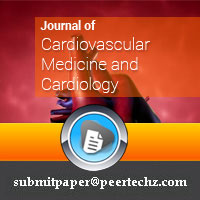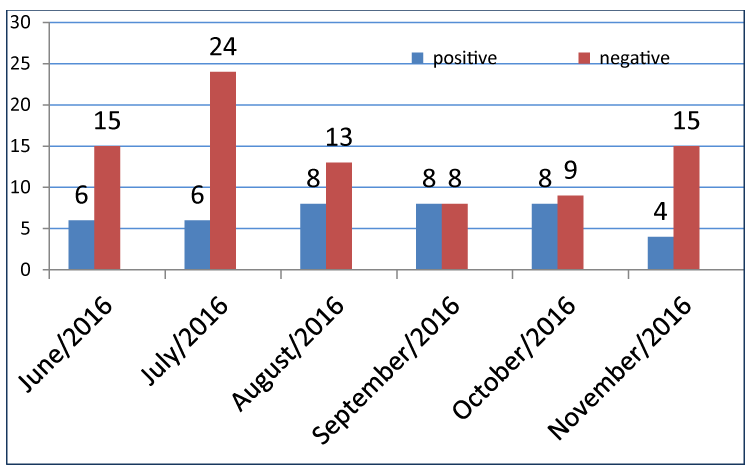Open Journal of Bacteriology
Blood culture: Profile of bacterial infections of newborns admitted from maternity
Bennaoui F1,2*, El Idrissi Slitine N1,2, Benbahia A1,2, Soraa N3 and Maoulainine F.M.R1,2
2Team for Childhood, Health and Development, Marrakech School of Medicine, Cadi Ayyad University, Marrakech, Morocco
3Microbiology department, University Hospital Mohamed VI. Marrakech, Morocco
Cite this as
Bennaoui F, El Idrissi Slitine N, Benbahia A, Soraa N, Maoulainine FMR (2018) Blood culture: Profile of bacterial infections of newborns admitted from maternity. Open J Bac 2(1): 001-003. DOI: 10.17352/ojb.000006Blood culture provides an undeniable ideal aid in the diagnosis of neonatal infection, its result is reliable. The aim of our work was to evaluate the bacteriological profile of bacteraemias, newborns admitted from the hospital maternity IBN TOFAIL.
A retrospective study on the cases of newborns hospitalized in the neonatal care unit, Mohamed VI University Hospital, Marrakech, originating from the delivery room of the IBN TOFAIL Gynecology and Obstetrics Department, during a period of 6 months From June to November 2016.
125 blood cultures were collected, 43 were positive, representing an overall positivity rate of 34.4%. Positive blood cultures by coagulase-negative staphylococcal were 27. The other bacteremias were 16, represented by multiresistant germs, with the predominance of Klebsiella pneumoniae (5 cases), Acenitobacter Baumanii (4 cases) and Serratia marcescens in 3 cases.
Bacteremia on admission; especially to multidrug-resistant germs, presents a major problem of therapeutic management. We insist on the need to improve the conditions of delivery in our context and to develop new diagnostic and therapeutic strategies.
Introduction
Neonatal infections require an optimal diagnostic and therapeutic strategy because of the high mortality rate. Its diagnosis is based on a set of clinical, biological, radiological and microbiological criteria. Blood culture is the examination of choice allowing a diagnosis of certainty, if its result is reliable. False positives and false negatives of a blood culture may mislead the diagnosis.
The aim of this study was to study retrospectively all the diagnosed bacteremias of infants born from the IBN TOFAIL maternity, to determine the distribution of the microorganisms isolated from blood cultures and their sensitivity to antibiotics, and from this data, systematic blood culture in the diagnostic and therapeutic management, with discussion of newborn specialties and a literature review.
Materials and methods
This is a retrospective study of hospitalized newborns; which were born at the IBN TOFAIL maternity hospital, MARRAKESH, during the period from June to November 2016. Age was less than 29 days, excluding newborns from other hospital structures and from the home. The total number of patients collected was 126.
Confidentiality’ relates to the protection of the data collected. Where the aim of our research is specifically to access private files, the anonymity and the confidentiality were respected.
A blood culture was routinely performed on admission to the unit for all hospitalized newborns, irrespective of the admission‘s diagnosis and befor the antibiotic therapy.
Blood culture samples were taken in a peripheral vein. The method of dermal antisepsis prior to collection consists of brushing with 0.5% alcoholic chlorhexidine. The lid of the hemoculture flasks is disinfected.
Results
We collected 126 newborns during the study period. The birth weight varied between 900g and 5600g. The monthly distribution of the germs is illustrated in figure 1.
The number of patients with positive blood cultures was 43; an overall positivity rate was 34.4%. The sex of patients with positive blood cultures: 62% female and 38% male, sex ratio was 1.6%.
The microorganisms isolated in the blood cultures are described in table 1. Positive blood cultures with Coagulase negative staphylococci (CoNS) were 27, representing 21% of the total of the patients and 62% of the positive blood cultures.
Of the positive blood cultures by CoNS, 22 cases were incontestable because no clinical or biological evidence of systemic infection was found. The overall rate of contaminants was 22/126 (17.4%).The overall rate of bacteraemia was 21/126 (16.6%).
In five cases the CoNS was responsible for a true infection, including a case of sepsis. The CoNS were multisensitive in all cases.
The most frequently encountered microorganisms were 16, mainly composed of multiresistant germs, with the predominance of Klebsiella pneumoniae (5 cases), Acenitobacter Baumanii (4 cases) and Serratia marcescens in 3 cases.
All these germs are multiresistant. These germs were resistant to probabilistic antibiotic therapy used in the neonatal intesive care unit (3rd generation cephalosporin combined with Gentamicin).
Klebsiella pneumoniae and Serratia marcescens were resistant to cephalosporins, sensitive to Imipenem, Amikacin and Colistin. Acenitobacter Baumanii was sensitive only to Colistin.
Good evolution in patients with positive blood cultures was 49%, and the mortality rate was 51%.
Discussion
The diagnosis of neonatal infection is difficult, based on a set of clinical, biological, radiological and microbiological criteria. Clinical signs are atypical and sometimes non-existent. Blood culture provides undeniable help if its result is reliable [1]. In the newborn, blood cultures are among the most frequent diagnostic tests in hospitals. They are crucial for the diagnosis and management of many infections. False positives and false negatives of a blood culture may lead to diagnosis and treatment, and are a source of overcontrol [2].
Blood culture is used to detect the passage of microorganisms in the blood, to identify them and to characterize their susceptibility profile to antibiotics. Very many pathogens can be isolated from blood cultures. They are of community or nosocomial origin. Detection and identification strategies depend on the clinical context, and biologists need to be involved in the clinical and therapeutic choices that arise.
In a study carried out in 1996 on newborns: The overall positivity of blood cultures was 6.25%, with an overall contamination rate of 1.7% and a true bacteraemia rate of 4.1% [3]. Paisley reported in a neonatal study: a positivity rate of 4%, detection sensitivity of neonatal bacteremia appears low: 75% of patients admitted to pediatric intensive care, having infection criteria, had negative blood cultures [4].
Our results are almost similar to those found in a study carried out between April 2007 and March 2011 at the level of 7 neonatal intensive care units level II and III which were: 50.5% SCoN, 5.9% Klebsiella p. and 3.5% Enterobacter sp. [5].
Contamination is not uncommon and reduces the specificity of blood cultures. The scientific literature reports a contamination rate of up to 50% of all blood cultures [6].
The arguments suggesting a contamination are the evidence in a single blood culture, the demonstration of different SCN or morphotypes with different resistances. The rate of contamination of the blood cultures may be reduced by rigorous asepsis during sampling. The sensitivity of detection of neonatal bacteremia can be accorned by taking a blood volume of 1 to 2 ml, determined according to the clinical context. However, in neonates the blood culture remains difficult. This difficulty contributes to the risk of contamination during sampling and to the risk of lack of sensitivity due to the impossibility of taking blood volumes equivalent to those taken in adults (5 to 10 ml) [7].
SCoN are the most commonly isolated pathogens in the neonatal intensive care unit (NICU), it is a commensal microorganism of the skin, and isolation in the culture may reflect contamination. SCoNs generally have low virulence. In our series, there was a high prevalence of SCoN positive blood cultures, which is consistent with the literature [8].
Some researchers have defined SCoN infection as either two positive positive blood cultures within two successive days or a positive culture associated with a high C-reactive protein. For patients <1 year of age, the Centers for Disease Control and Prevention define SCoN infection as the presence of clinical signs (eg, hyperthermia, hypothermia, apnea or bradycardia) and isolation of SCoN from two or more several haemocultures. The common objective of these different definitions is to distinguish the infection by the CoNS from the contamination [9].
Our study revealed the presence of bacteremia with micro-resistant germs, which should have nosocomial infection discussed; especially in the case of a compatible clinical picture.
Conclusion
Blood culture remains a valuable examination to establish the microbiological diagnosis of septic conditions in the emergencies. The diagnosis of neonatal infection is often difficult and the positivity of the blood culture provides an undeniable help. New technologies promise a revolution in the diagnosis of bacteremia in the coming years. Biomolecular methods will enable automated, rapid and reliable identification.
Due to the high costs to be expected with these technologies, a more precise indication and prevention of contamination are essential.
- Messer J, Eyer D, Donato L, Gallati H, Matis J et al. (1996) Evaluation of interleukin-6 and soluble receptors of tumor necrosis factor for early diagnosis of neonatal infection. J Pediatr 129: 574-580. Link: https://goo.gl/syzVqi
- Deen J, von Seidlein L, Andersen F, Elle N, White NJ, et al. (2012) Community-acquired bacterial bloodstream infections in developing countries in south and southeast Asia: a systematic review. Lancet Infect Dis 12: 480–487. Link: https://goo.gl/UPRqpV
- Saint-Laurent R, Belmekki M, Denis R, Entzwerle N, Simeoni U, Messer J, Jaulhac B, Bientz M (1998) Blood cultures in neonatalogy unit : A retrospective study in the Strasbourg university hospital. Méd Mal Infect 28: 947-951.
- Paisley J W, Lauer B A (1994) Pediatric blood cultures. Clin Lab Med 14: 17-30. Link: https://goo.gl/rguBwy
- Blanchard AC, Fortin E, Rocher I, Moore DL, Frenette C,et al. (2013) Quach C.Central line-associated bloodstream infection in neonatal intensive care units. Infect Control Hosp Epidemiol 34: 1167-1173. Link: https://goo.gl/Y4vLyb
- Senger SS, Saccozza ME, Yuce A (2007) Compatibility of pulsed-field gel electrophoresis findings and clinical criteria commonly used to distinguish between true coagulase-negative staphylococcal bacteremia and contamination. Infect Control Hosp Epidemiol 28: 992–996. Link: https://goo.gl/uUPAie
- Hossain B, Islam MS, Rahman A, Marzan M, Rafiqullah I, et al. (2016) Understanding Bacterial Isolates in Blood Culture and Approaches Used to Define Bacteria as Contaminants: A Literature Review. Pediatr Infect Dis J 35(5 Suppl 1): S45-51. Link: https://goo.gl/vKafaH
- Stoesser N, Moore CE, Pocock JM, An KP, Emary K, et al. (2013) Pediatric bloodstream infections in Cambodia, 2007 to 2011. Pediatr Infect Dis J 32: e272-276. Link: https://goo.gl/r9hfNV
- Garner JS, Jarvis WR, Emori TG, Horan TC, Hughes JM (1996) CDC definitions for nosocomial infections. In: Olmsted, RN., editor. APIC Infection Control and Applied Epidemiology: Principles and Practice. St. Louis: Mosby A1-A20. Link: https://goo.gl/Fo2U6L

Article Alerts
Subscribe to our articles alerts and stay tuned.
 This work is licensed under a Creative Commons Attribution 4.0 International License.
This work is licensed under a Creative Commons Attribution 4.0 International License.

 Save to Mendeley
Save to Mendeley
